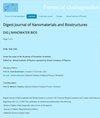掺锶铋硼酸盐玻璃的制备与表征
IF 1
4区 材料科学
Q4 MATERIALS SCIENCE, MULTIDISCIPLINARY
Digest Journal of Nanomaterials and Biostructures
Pub Date : 2024-06-06
DOI:10.15251/djnb.2024.192.773
引用次数: 0
摘要
利用熔体淬火法,合成了新的硼酸铋玻璃成分,即 (40+x)Bi2O3-(60-x-y)B2O3-ySrO (x 和 y 在 0 到 20 摩尔% 之间)。X 射线衍射分析证实了所有玻璃样品的无定形性质,表明它们不存在晶体材料中常见的长程有序性。同时,傅立叶变换红外光谱分析揭示了玻璃中基本结构单元的存在,包括 BO3 和 BO4 三面体和四面体单元,以及 BiO3 和 BiO6 多面体,这表明玻璃具有复杂的网络结构。差热分析(DTA)和扩张仪评估了玻璃的热性能。差热分析表明玻璃具有很高的热稳定性,稳定值高达 106°C,而且随着氧化锰的增加,稳定性也会提高。稀释分析表明,这些玻璃具有较高的热膨胀系数(8.69 至 10.7 ppm/°C),玻璃转化温度相对较低,在 362 至 432°C 之间,稀释软化温度在 380 至 447°C 之间。通过密度测定以及摩尔体积和氧堆积密度计算,对样品有了进一步的了解。与其他重金属氧化物玻璃相比,本研究中的玻璃具有明显的高密度值,介于 6.279 和 7.476 g/cm3 之间。本文章由计算机程序翻译,如有差异,请以英文原文为准。
Preparation and characterization of strontium-doped bismuth borate glasses
Employing the melt quenching method, new bismuth borate glass compositions denoted as (40+x)Bi2O3–(60-x-y)B2O3–ySrO, with x and y ranging between 0 to 20 mol%, were synthesized. The X-ray Diffraction analyses confirmed the amorphous nature of all glass samples, indicating the absence of long-range order typically seen in crystalline materials. Concurrently, the Fourier-transform Infrared Spectroscopy examinations unveiled the existence of fundamental structural units within the glasses, including BO3 and BO4 trigonal and tetrahedral units, as well as BiO3 and BiO6 polyhedra, suggesting a complex network structure. Differential Thermal Analysis (DTA) and dilatometry assessed the glasses' thermal properties. DTA demonstrated the glasses' high thermal stability, with a stability value of up to 106°C, noting that stability improves with more SrO. Dilatometry analyses revealed these glasses exhibit a high thermal expansion coefficient, ranging from 8.69 to 10.7 ppm/°C, alongside relatively low glass transition temperatures between 362 and 432°C and dilatometric softening temperatures spanning from 380 to 447°C. Density measurements were conducted, followed by molar volume and oxygen packing density calculations, to glean further insights into the samples. Compared to other heavy-metal oxide glasses, the glasses examined in this study exhibited notably high-density values, ranging between 6.279 and 7.476 g/cm3 .
求助全文
通过发布文献求助,成功后即可免费获取论文全文。
去求助
来源期刊

Digest Journal of Nanomaterials and Biostructures
工程技术-材料科学:综合
CiteScore
1.50
自引率
22.20%
发文量
116
审稿时长
4.3 months
期刊介绍:
Under the aegis of the Academy of Romanian Scientists
Edited by: -Virtual Institute of Physics operated by Virtual Company of Physics.
 求助内容:
求助内容: 应助结果提醒方式:
应助结果提醒方式:


